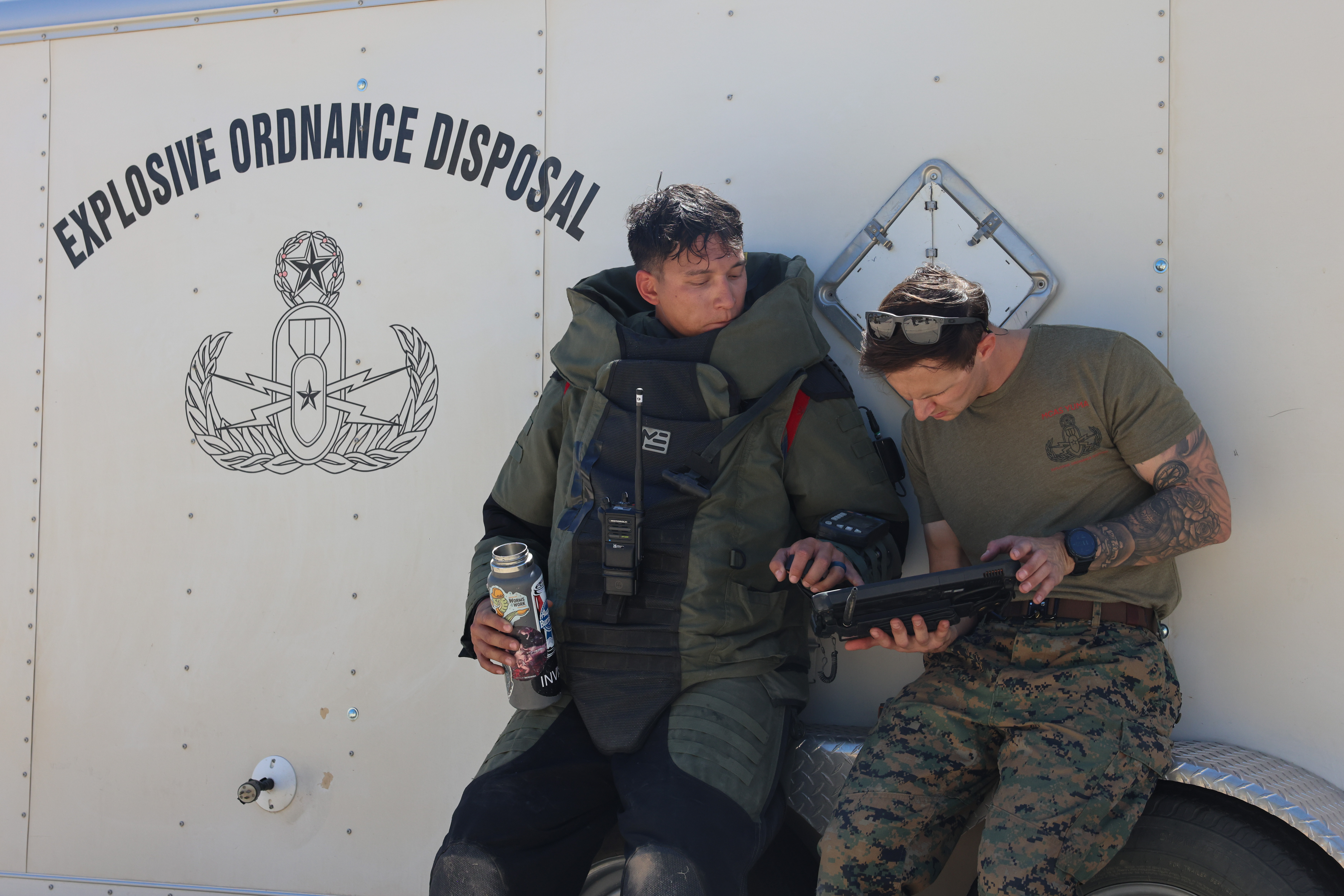
CAMP PENDLETON, Calif. – In the next major conflict, the U.S. military sees Marines and other U.S. forces deployed across the Indo-Pacific and facing an agile, tech-savvy and equally-capable enemy.
But unlike prior wars, a peer-on-peer fight won’t only take place overseas.
Threats will abound at home installations to the digital connections that drive military information, intelligence, logistics, command and control. The bases and air stations that support the resupply, training and deployment of forces, safeguard military families and workers, and sustain the forward fight will also face threats, as will the underlying infrastructure that connects it all, enables the wider capabilities of the U.S. military, and supports defense contractor establishment.
To prepare for those real-world threats, Marine Corps Installations-West’s bases and stations recently spent the better part of a week tackling what that future fight might look like when threats strike at home. Its bases would serve as the “Gateway to the Pacific,” much as they did during World War II and the wars in Korea and Vietnam.
To get at this issue, the Marines war-gamed a range of scenarios – including simulated active-shooter events, suspicious bombs, base intruders, gate runners and misinformation about operations – during exercise Semper Durus 2023. The training ran from April 10 through 14 at Marine Corps Base Camp Pendleton, Marine Corps Air Station Miramar in San Diego, Barstow Marine Corps Logistics Base in California and at Yuma MCAS in Arizona.
“We are optimizing ourselves in order to be able to address, defend and disrupt against full-spectrum threats,” said Col. Philip Laing, MCI-West’s acting chief of staff and the G3/G5 operations chief with the Camp Pendleton-based command that oversees installations across California and Arizona. “We’re not static. It’s not a garrison mindset, it’s an operational mindset.”
“The U.S. is no longer a sanctuary,” Laing noted. “We need to honor the threat. There will be no rear area in the future conflict.” Moreover, he added, “the ability to project combat power at a time of conflict has to originate from the homeland.”
The overall goal of Semper Durus 2023 – a command post exercise crafted with Force Design 2030 in mind – was for MCI-West’s bases and stations to form an integrated, regional defense and strengthen their physical security, all while protecting the installations as I Marine Expeditionary Force’s operational units train, prepare and deploy into battle.
Today’s threat landscape – from suspicious drones to base infiltrators and cyber-attacks – has military officials rethinking the approach to prepare installations for threats closer to home, whether foreign or domestic. It’s a sea change from the focus on anti-terrorism, asymmetric threats and force protection following the 2000 terrorist bombing of destroyer USS Cole (DDG-67) and the Sept. 11, 2001 attacks one year later.
“That’s not the world we live in anymore,” Laing told USNI News in April as the exercise unfolded.
“Fight the installation – what’s that? What does that mean? To me, that’s the defense. To me, that’s our ability to defend against all-spectrum threats,” he said. “Semper Durus has given us an opportunity to give that a heart beat, to at least experiment with what ‘fighting the installation’ means.”
Operational Focus
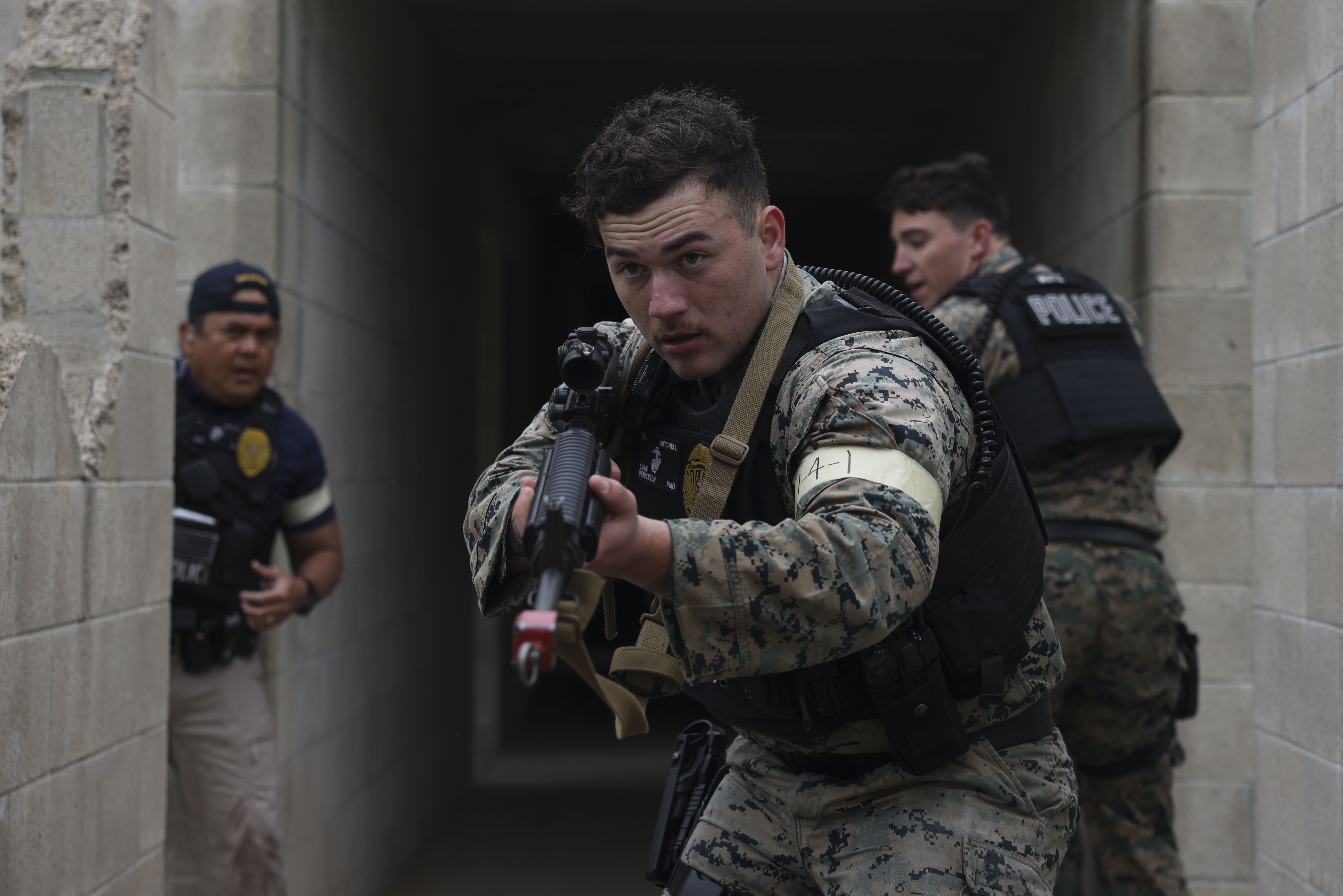
Semper Durus planners drew up scenarios based on threats across various warfare domains that kept each installation’s Emergency Operations Centers abuzz during round-the-clock operations. It marked a big change for EOCs more accustomed to dealing with wildfires, floods and the occasional gate runner.
“For this exercise, I’m taking us into a situation or scenario where we are in conflict, we are up against a state actor,” said Laing. “That’s what makes this scenario different.”
They tapped the base’s Training Support Center, which supports I MEF, and developed the “road to war” training objectives for Semper Durus.
While concerned about base security and intrusion, they also looked to air, maritime and cyber threats. “We’re talking inside the wire,” he said. The Marines also took serious looks into available resources and capability gaps. In the air, “the pacing threat” comes from small, unmanned air systems, he said. Camp Pendleton’s 17 miles of coastline pose another front to the threat, and the non-kinetic danger in cyber “is a very real and a very significant threat.”
The exercise wasn’t solely a computer-generated, command-post exercise. Marines and sailors from various I MEF units participated as enablers, getting realistic training from simulated threat events. They included Charlie Company of 1st Battalion, 1st Marines; a Raven drone team from 23rd Marine Regiment; an engineer detachment from 1st Combat Engineer Battalion; a platoon of Marines from 1st Marine Logistics Group; and two platoons of Marines with 3rd Marine Aircraft Wing.
Most formed into Security Augmentation Forces that were designed “to thicken our defense, or to employ a layered defense,” Laing said. “If something happens, and there’s an intrusion on the air station, what [does] the defense look like beyond the gate?”
Regional Bases in Play
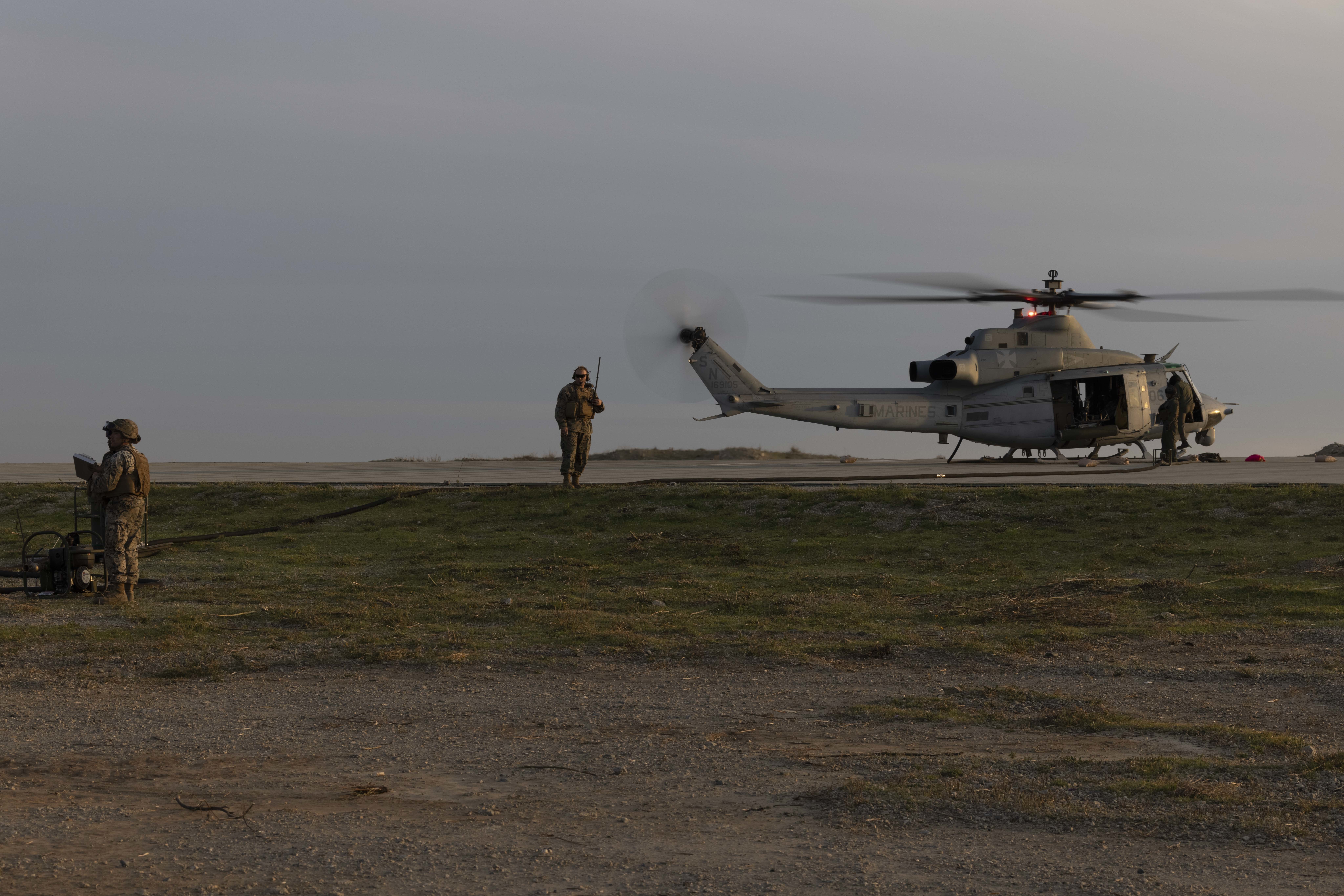
As Laing spoke, the MLG platoon was flying to Barstow aboard an MV-22B Osprey aircraft on an assault-support mission to respond to a threat. The mission tested the command at the small, desert base – it’s a key logistics hub with a major railhead – to receive and integrate the force into its mission, so it was a good drill for the command, the colonel noted.
At Yuma, explosive ordnance disposal technicians and ground robotic vehicles dealt with a suspicious vehicle. At Miramar, air station officials grappled with several scenarios, including protesters gathered at a gate, a lockdown due to an active shooter and a wildfire threatening the flight line.
At one point, the air station lost its access to the power grid for nearly 12 hours, deliberately. “We shut off all power … for about 10 to 12 hours, which is the longest we’ve ever done,” said 2nd Lt. Jacoby Hawkins, a Miramar spokesman. But the air station’s micro-grid provided power to the flight line and other facilities that enabled no disruption to operations.
One morning at Camp Pendleton, investigators, K-9 teams, military police and officers with the Security and Emergency Services battalion responded to a new kind of scenario: suspected base intruders were shooting at multiple people as they moved into an urban training site. “This scenario (was) an opportunistic threat that was inspired by a state actor,” Laing said. By working with Charlie 1/1 “to respond to that threat, it starts to develop battle drills.”
“We’ve got to be prepared for that type of situation,” he said. “How do we deal with the threat – eliminate the threat – while simultaneously taking care of casualties?”
That was part of what the security teams – most hadn’t worked together before – had to tackle as they moved through the mock town’s buildings and streets, where roofs, sublevels and drainage pipes were potential hiding spots for enemy shooters. Timothy Wells, a range safety officer and former Marine, pointed out several ground-level openings one team hadn’t cleared. “There still can be a threat in there, so you just can’t walk past it,” said Wells.
The training “is an eye-opener. Maybe you thought that your skills were good. Maybe they’re not so good,” he said. “It shakes them up a little bit. It keeps them on their toes.”
Command Echelons
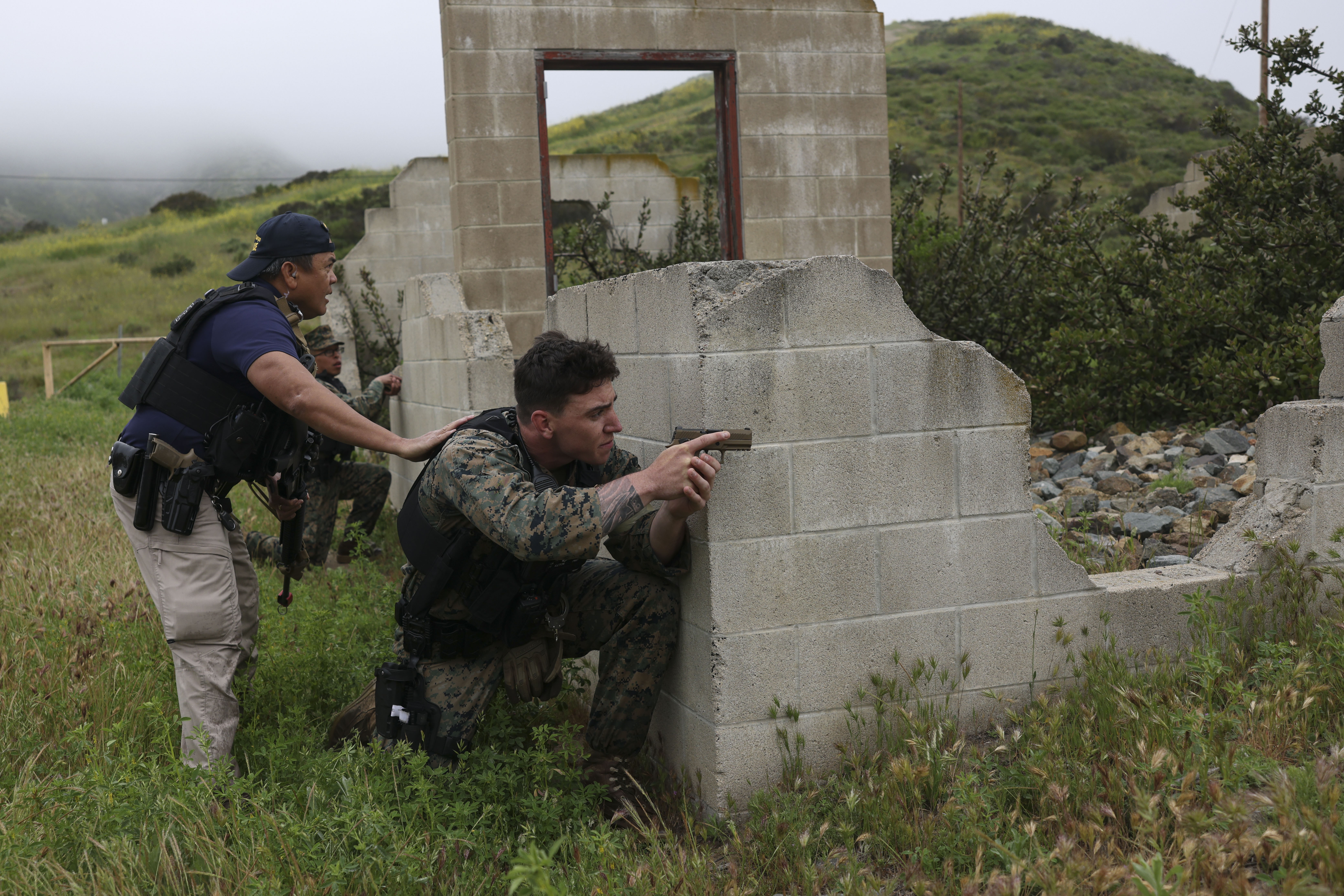
Threats to the homeland spur a different, whole-of-government response. Some Semper Durus scenarios, if real, would draw in other federal and state agencies and law enforcement organizations. “It can get complex real quick,” Laing said.
“A civil disturbance outside our gate that’s inspired by a state actor – how do I coordinate?” he said. “That vignette will start to drive discussions up through the chain of command, and it focuses the discussion.”
Semper Durus 2023 ran simultaneously with Vigilant Shield, the annual homeland defense exercise by the North American Aerospace Defense Command and U.S. Northern Command.
The U.S-Canada command-post exercise is designed to assess and enhance the readiness of NORAD and NORTHCOM, with a classified scenario “designed to assess and enhance NORAD and USNORTHCOM’s ability to defend North America across all domains, which include air, land, maritime, space and cyber,” according to the commands.
Having the superior headquarters in play “forces us to get disciplined,” Laing said, and forces EOCs and commanders on the ground to figure into “a higher headquarters battle rhythm.”
The planning and practice drills are important to prepare Marines and set the mindset for what they would face in the midst of a real-life conflict. “The faster it comes and the more complex it is, it starts to galvanize,” said Laing. “I used to tell Marines, your mind changes at gunpoint. The threat’s real. It’s not like we’ve got 10 years to train for it. It’s now.”
Semper Durus 2023 “gives us a framework to anchor to and develop and validate requirements,” Laing said. After delving into after-action reports, MCI-West officials will begin work on next year’s exercise. “It’s going to grow in scope and in complexity,” he said, “and it’s got to be rehearsed.”
Force Design in Mind
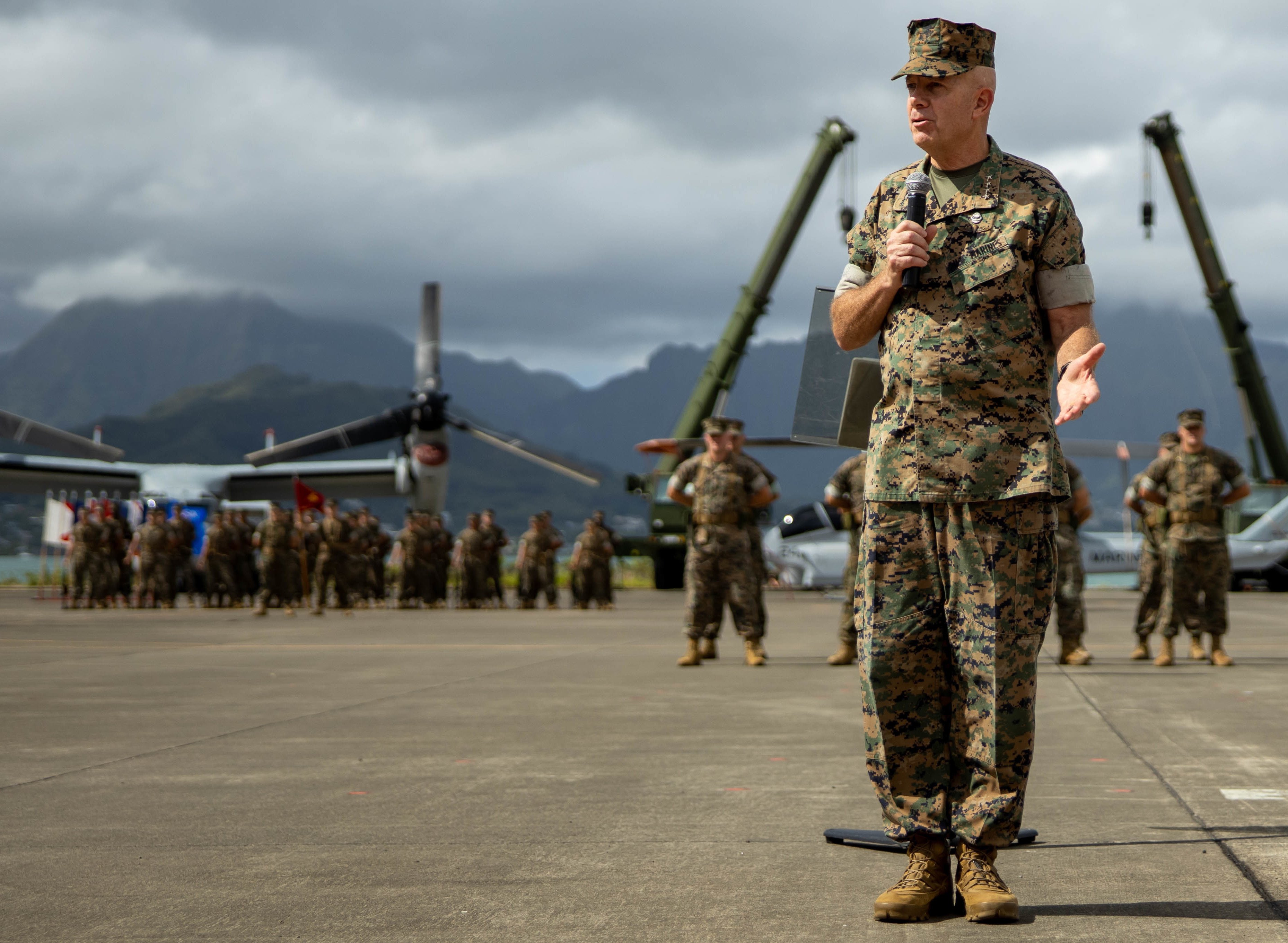
MCI-West planners crafting the exercise incorporated the future threats as outlined in the Marine Corps’ Force Design 2030 to delve into a fight-the-base concept that’s still nascent.
“We took that same approach within MCI-West the way that I MEF takes the approach – peer versus peer, multi-domain, high-intensity combat scale – [against] a peer adversary, state actor,” Laing said. “So how do we protect the force in order to enable force projection?”
As I MEF goes forward into the fight, he added, “how do we train, sustain and maintain those formations, while protecting them. That’s how we’re kind of looking at the problem set.”
For this year’s drills, they took a page from the infantry playbook. “In order to synchronize and align capabilities … we’re setting a regional defense just like the 1st Marine Division establishes a defense, where you coordinate, integrate and synchronize resources to protect, in this case, power projection,” Laing said, adding that “the opportunistic threats are still very real.”
“If you’re defending everywhere, you’re defending nowhere,” he added. “I need to be able defend at the right place at the right time with the right asset and the right domain against a state actor. And at the end of the day, I need to understand what are the resources necessary to be able to do that, because there is no rear area in conflict.”
This year’s exercise incorporated goals contained in the Installations and Logistics 2030 concept and the updated Logistics, Marine Corps Doctrinal Publication 4, both issued earlier this year.
Eye on 2030
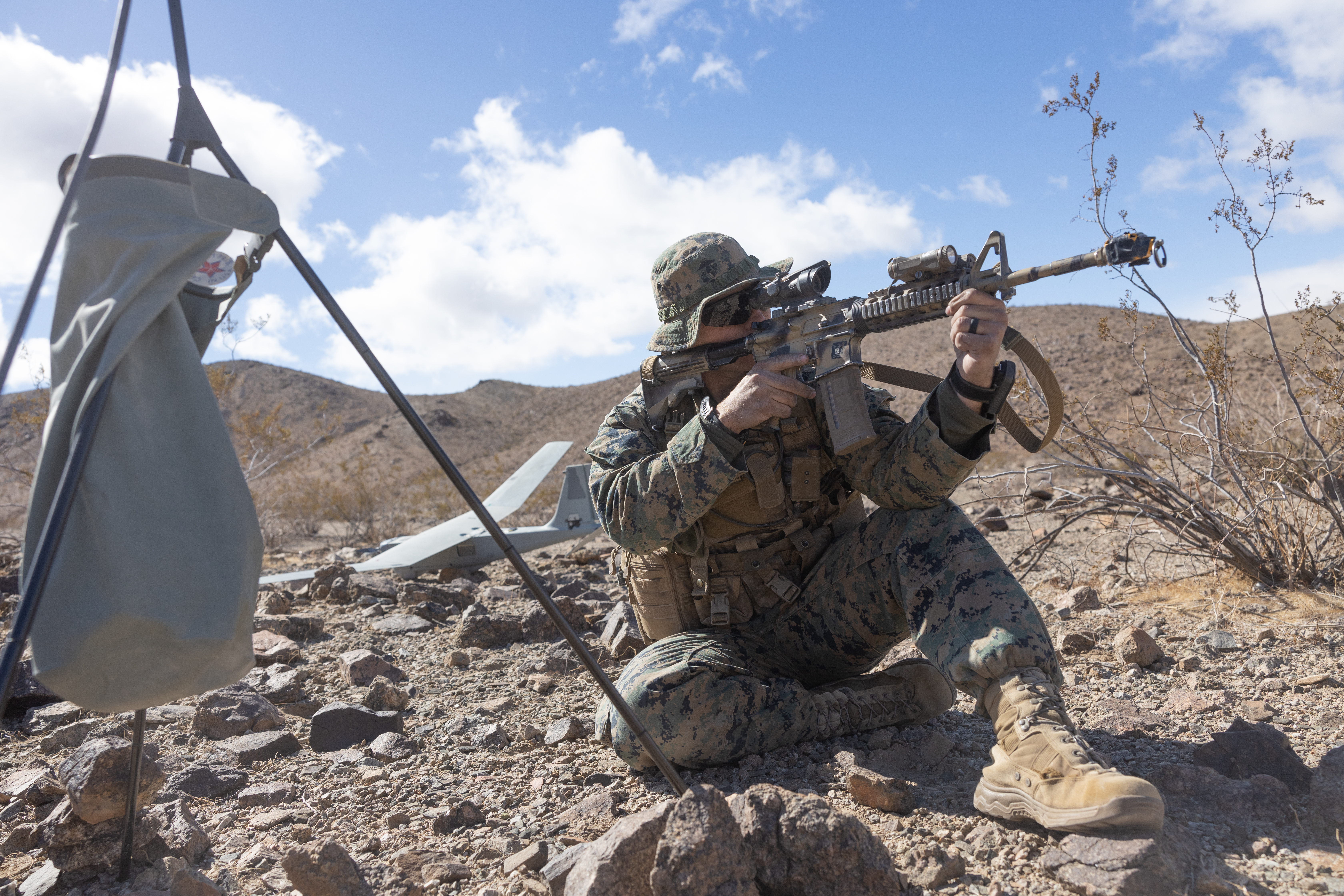
In its I&L 2030 concept released in February, the Marine Corps refocused its concept of contested logistics and installations’ roles to sustain deployed forces and protect against peer threats that extend to the homeland.
“Transforming our current installations and logistics related capabilities, capacity, and resiliency to support the future force more effectively, while reducing risk to our units, Marines, sailors, families, and allies and partners is paramount,” Marine Corps Commandant Gen. David Berger wrote when announcing the document. “The time for action is now.”
“Our installations will play an even greater role supporting our warfighting concepts than in recent past,” the I&L concept states. It adds: “In light of emerging threats, we will reanalyze the force protection warfighting function and reconsider what tasks have to be executed from our bases and stations as we move from competition to crisis to conflict.”
It’s no small responsibility. The Marine Corps oversees 25 installations; 25,197 family housing units, 82 mess halls, 28,745 buildings on 2.5 million acres, 36 runways across 10 airfields, and 1,780 ranges and training areas, according to I&L 2030.
Berger directed the Marine Corps to finish numerous reviews and actions this year. “Due to the emerging and expanding threats facing our installations, we must ensure force protection efforts enable continuity of operations, protection and safety of our families, and our forces to meet operational requirements,” I&L 2030 states. “This will include a full review of existing plans, to include identifying gaps between current installation capabilities, capacities, and (command and control).”
Among other tasks is a Sept. 1 deadline for the deputy commandant of installations and logistics to “develop a resiliency assessment and recovery plan by base/station regarding force protection; critical energy and utilities support; airfield operations; training range support; and command, control, and communications.”
Logistics (MCDP 4), released in March, acknowledged those greater risks to installations and their roles in supporting fighting forces. “Technological advances have enabled adversaries to reach, attack, and disrupt U.S. military operations around the world, often with little or no notice. These advances can hinder the forces’ logistics efforts where units are forward-deployed or stationed at U.S.-based installations,” the document states. “Threats exist in all domains and the enemy will attack using every available weapon system and means to disrupt U.S. operations.”
So in the future fight, deploying and follow-on forces must be sustained and protected wherever they are. “The installations that serve as nodes in this system must prepare to be attacked across multiple domains,” it adds. “Plans to harden, disperse, avoid, and regenerate forward bases must be resourced and rehearsed.”





